-
Safe Travels
Posted on October 31st, 2018 No commentsGlider team has arrived in Mirissa Sri Lanka! Glider is approximately 17 km off shore in 1000m water. There is a scheduled boat trip to recover glider Friday at 6am (Sri Lanka time) at Welligama Bay.
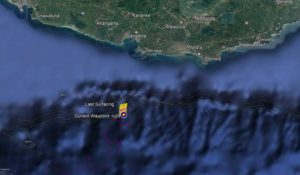
Attached are glider packing test fits for RU29 when it is home bound.
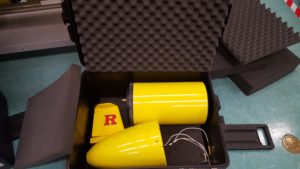
energy bay hull+tail
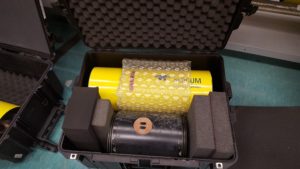
science bay+aft hull
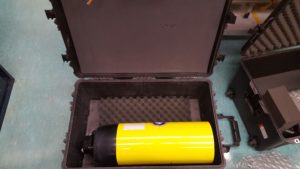
front end
-
70 kilometers to pick up point
Posted on October 20th, 2018 No commentsWe did some tests flight tests on Friday, and are now back to heading towards the pick up point. The latest measured heading plot shows RU29 is now flying about 60 degrees to the right of the commanded heading.
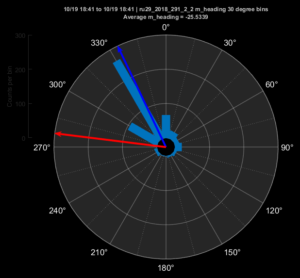
Below image is zoomed into the local area with the new Copernicus model currents. The direction we want to head is to the NE, at a heading of about 30 degrees. With the 60 degree offset noted above, we can give RU29 a waypoint that is to the NW at a heading of 330 degrees. That new waypoint is shown in the cyan color.
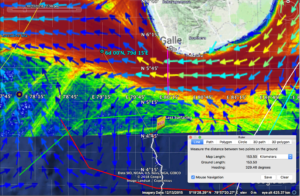
The Copernicus currents show that there is a strong current to the west just south of Sri Lanka in the region with the high vessel traffic. That means there are two hazards if we move into that area, vessels that can hit us and currents that can sweep us away.
Below is the important model comparison. You always hope the models agree so that you have more confidence in the currents.
First is Copernicus, the European model. There is a strong alongshore current to the west offshore suthern Sri Lanka that covers the shipping lanes in red. RU29 is in a relatively low current zone, near the middle to western side of a counterclockwise eddy. Currents at RU29 are weak ant to the south.
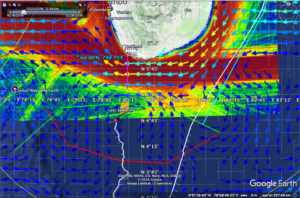
Now for the two US models. First the Navy HYCOM. Here RU29 is on the eastern side of a very strong and elongated clockwise eddy. The elongation is in the direction of altimeter tracks – wish I could overlay them somehow. The strong eddy is disrupting the alongshore flow by southwestern Sri Lanka and turning it to the east. Currents at RU29 are strong and to the southeast.
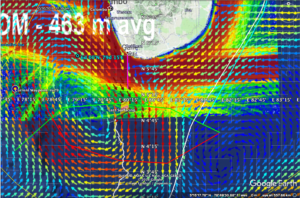
Last is NOAA RTOFs. Same story as Hycom, bit now the eddy is round, not elongated like an altimeter track.
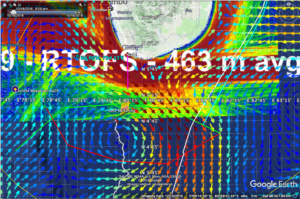
-
Position prior to flight tests
Posted on October 19th, 2018 No commentsMeasured heading rose has RU29 flying about 115 degrees to the right of the commanded heading
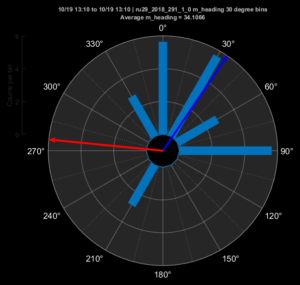
We made the waypoint change to give a commanded heading near 300 degrees. This turned the glider to fly more like an ENE direction, directly at our proposed pick up point. We are 70 km away from that point that is 40 nautical miles south of Galle, Sri Lanka and is right on the souther edge of the shipping lanes. We have been making about 15 km of progress per day.
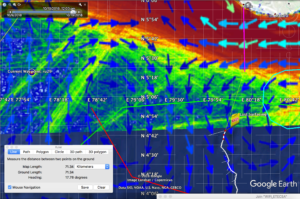
We will be doing some flight tests for the remainder of this day (friday) in preparation for the station keeping we will need to do at the pick up point.
-
Rapid near surface temperature change in Michael
Posted on October 18th, 2018 No commentsHere is a comparison of the temperature in the upper mixed layer (10 m depth and 20 m depth) at the location of Navy Glider 288. Hurricane Michael passed within less than 50 km of ng288. The swath of tropical wind scale winds was about 500 km wide, so this was relatively close to the track of the hurricane. And the glider was on the right had side of the track, so perfectly placed in the most intense winds.
Solid black vertical line is time of hurricane eye passage over Navy Glider 288. Dashed black vertical lines are data assimilation times.
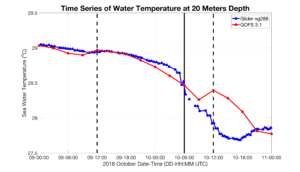
The agreement between the surface layer temperature observed by ng288 and the GOFS 3.1 forecast is remarkable. The model even appears to be cooling the surface layer at the proper rate. Note that most of the observed cooling occurs after eye passage, the opposite of what we see in the Mid Atlantic.
The dashed line at 1200 on Oct 10 will be an interesting case to study with our colleagues. We assume the glider data is being assimilated, our friends at NRL are good at checking for this. During this time of rapid temperature change, if glider data from earlier in the day is assumed to apply at noon on Oct 10, it will try to increase the temperature as we observe here. The model then appears to cool the temperature at the right rate despite being incorrectly offset boy about 0.5C.
Establishing what happened through the data assimilation during the passage of Michael over ng288 will be a great research question for us to prusue over the winter as we prepare for the 2019 hurricane season.
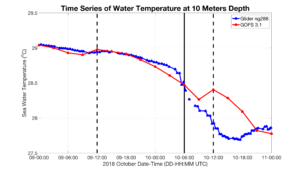
-
Third Test – same answer
Posted on October 13th, 2018 No commentsWaypoint to west, with commanded heading in red towards 270 degrees. Average heading towards 30 degrees, or 120 degrees to the right of the commanded heading.
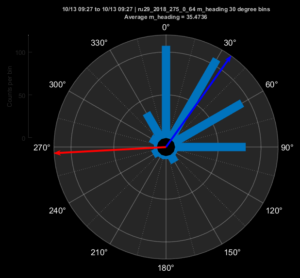
Glider moved in the direction of the averaging heading, towards the northeast. So no currents for third try, Copernicus (the currents shown here) is a clear winner.
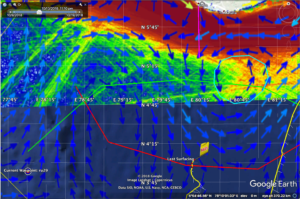
We are 150 km from our intended pick up point just south of the shipping lanes. We are averaging 15 km/day. So 10 days from today, Oct 13, is Tuesday, Oct 23. Gives us a several day window for unexpected currents beyond that.
-
Second test – time to shift waypoint north
Posted on October 13th, 2018 No commentsThe heading rose plot from the last segment has an average heading 75 degrees to the right of the commanded heading. So we do not have an steady offset or trend. Sometimes the offset is less than 90 degrees to the right. Sometimes more. But it tends to oscillate around 90 degrees to the right of the commanded heading.
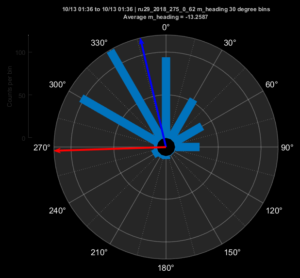
During this segment the glider moved to the northwest, in the direction of the average heading. So the currents are low. More evidence copernicus model is right. Copernicus currents are shown here.
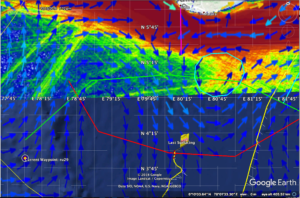
So our plan is to continue sliding the waypoint north a little bit each day and walk this glider up to the edge of the shipping lanes, about 40 nautical miles south of Galle.
Current waypoint is just south of 4 N. We can shift it 10′ north to about 4 degrees, 10′ north before the next surfacing in early afternoon.
-
Test dive with waypoint straight west
Posted on October 13th, 2018 No commentsRU29 is 125 nautical miles directly south of Galle, Sri Lanka. We objective is to continue moving Ru29 north towards Galle but to stay offshore of the 40 nautical mile wide (magenta line) shipping lanes. We have about 85 nautical miles (about 150 km) to go until we reach the southern side of the shipping lanes.
Ru29 has flown 50 km north in about 4 days. If we can keep up this speed, we can cover the next 150 km in 12 days, and be at the edge of the shipping lanes ready for pick up. So give us two weeks.
Today is Saturday, Oct 13. Two weeks from now is Saturday, Oct 27. So we would like to recover soon after Oct 27.
This plan depends on no major changes in the currents between our present location and our target location 150 km north. The last blog entry indicates that the models do not agree.
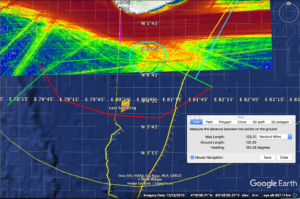
To determine which model is more likely to be correct, we did a test dive with the waypoint straight to the west. The compass heading rose shows the result. The red arrow shows the commanded heading. The light blue bars is a histogram in 30 degree increments of the direction RU29 actually flew. The dark blue arrow is the average heading, indicating we flew 120 degrees to the right of the waypoint, or towards 30 degrees east of north.
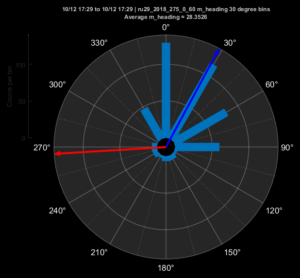
Here we zoom in to the location of RU29 and overlay the Copernicus currents. The glider moved to the northeast, and Copernicus says the currents by the glider are very low.
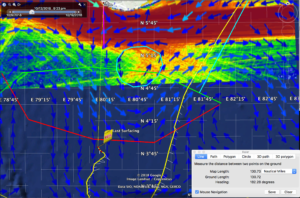
Now we remove the Copernicus currents and overlay the Hycom currents. HYCOM says the currents are strong and to the west. But the glider flew northeast.
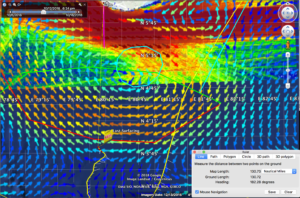
Looks like the Copernicus model is giving us a better result more consistent with the observed glider behavior. Zooming even closer in on copernicus, there is an eddy just to the south of the shipping lanes. The distance from RU29 to the center of the eddy is about 140 km, so again, less than 2 weeks away. If we park there, the distance from Galle to Ru29 will be 66 nautical miles.
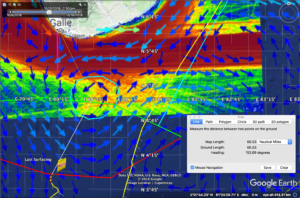
Hope is to bring RU29 a bit farther north than that, and sit at the outer edge of the shipping lanes, only 40 nautical miles from Galle.
-
Time series of near surface temperature from Navy Glider
Posted on October 12th, 2018 No commentsHere we take a time series look at the near surface (2o m depth) temperature reported by the Navy Glider as Hurricane Matthew went by.
The time of eye passage is shown by the vertical dashed line. Temperature increase is at one slower rate until about 05:00 on Oct 10, just before eye passage. We then see a more rapid temperature decrease for about 8 hours, most of which occurs after eye passage. By about 17:00 the near surface temperature starts to increase slowly. So three ocean response time periods.
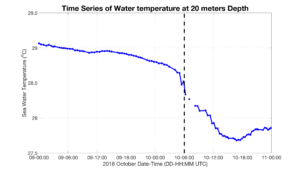
Next to check the model ….
-
Global Model profiles for Hurricane Michael
Posted on October 12th, 2018 No commentsBelow is the same plot as the Glider CTD data but for the Global Ocean Forecast System (GOFS) 3.1 model. Remarkably similar ocean. Differences are in the details.
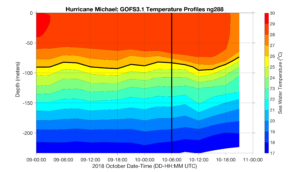
The 26C isotherm here is at a depth of about 90 m. The Navy glider has it at about 110 m, a bit deeper.
Surface layer cooling occurs more slowly in the model.
We will be looking into those details next.
-
Detailed CTD profiles in Hurricane Michael
Posted on October 12th, 2018 No commentsMaria is looking back at the CTD profiles collected during Hurricane Michael as it approached the Gulf Coast. In the figure below we have 2 days of CTD data from October 9 and 10. The 26C isotherm is indicated with a black line. The vertical black line 0n October 10 at 06:00 is the time of eye passage over the glider. The isotherms deepen most rapidly right after eye passage until about 09:00. Surface temperatures over the 2 days start between 29-30C and end between 27-28C.
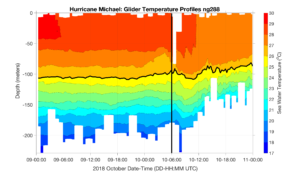
We will look at the time series of temperature at a depth near the surface, like 20 m, soon and get it posted.



